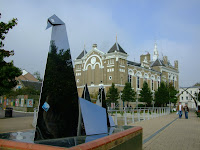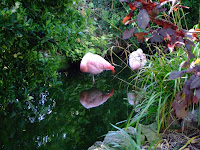 We left London in beautiful sunshine heading for Abingdon, quite a bit further up the Thames than yesterday, but as we dropped over the Chilterns into the Oxford valley we were enveloped in fog.
We left London in beautiful sunshine heading for Abingdon, quite a bit further up the Thames than yesterday, but as we dropped over the Chilterns into the Oxford valley we were enveloped in fog.Passing along the Dorchester bypass we were forced into a layby with no oil pressure in the engine so while Murray investigated the problem and waited for the AA, Christine walked into Dorchester-on-Thames to explore it in the fog.
 The church bells were peeling eerily in the invisible distance adding to the ambience of the otherwise still, foggy scene.
The church bells were peeling eerily in the invisible distance adding to the ambience of the otherwise still, foggy scene.The AA chap managed to rig a temporary repair and we made it to Abingdon just as the first of the other MG cars were leaving the town square. After collecting our route instructions we had quick stop to refuel and then set off after the other 25 or so MGs that had left before us.
 The route took us through the back-roads to Woodley, near Reading, and the destination for the run, The Museum of Berkshire Aviation.
The route took us through the back-roads to Woodley, near Reading, and the destination for the run, The Museum of Berkshire Aviation.It was apparent that the repair to the oil line was leaking so after a tour of the museum and a picnic lunch it was off to find a Halfords and a supply of 20-50W oil,
 something you cannot get at a service station these days.
something you cannot get at a service station these days.After a top-up and with the security of a can of oil in the boot, we set off for home dripping oil as we went but making it safely home regardless.
































